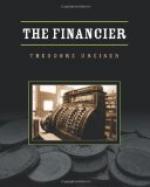There was a subtle advantage here, as Cowperwood pointed out to Stener. In the first place, since the certificates were going ultimately to reach par anyway, there was no objection to Stener or any one else buying low at the opening price and holding for a rise. Cowperwood would be glad to carry him on his books for any amount, and he would settle at the end of each month. He would not be asked to buy the certificates outright. He could be carried on the books for a certain reasonable margin, say ten points. The money was as good as made for Stener now. In the next place, in buying for the sinking-fund it would be possible to buy these certificates very cheap, for, having the new and reserve issue entirely in his hands, Cowperwood could throw such amounts as he wished into the market at such times as he wished to buy, and consequently depress the market. Then he could buy, and, later, up would go the price. Having the issues totally in his hands to boost or depress the market as he wished, there was no reason why the city should not ultimately get par for all its issues, and at the same time considerable money be made out of the manufactured fluctuations. He, Cowperwood, would be glad to make most of his profit that way. The city should allow him his normal percentage on all his actual sales of certificates for the city at par (he would have to have that in order to keep straight with the stock exchange); but beyond that, and for all the other necessary manipulative sales, of which there would be many, he would depend on his knowledge of the stock market to reimburse him. And if Stener wanted to speculate with him—well.
Dark as this transaction may seem to the uninitiated, it will appear quite clear to those who know. Manipulative tricks have always been worked in connection with stocks of which one man or one set of men has had complete control. It was no different from what subsequently was done with Erie, Standard Oil, Copper, Sugar, Wheat, and what not. Cowperwood was one of the first and one of the youngest to see how it could be done. When he first talked to Stener he was twenty-eight years of age. When he last did business with him he was thirty-four.
The houses and the bank-front of Cowperwood & Co. had been proceeding apace. The latter was early Florentine in its decorations with windows which grew narrower as they approached the roof, and a door of wrought iron set between delicately carved posts, and a straight lintel of brownstone. It was low in height and distinguished in appearance. In the center panel had been hammered a hand, delicately wrought, thin and artistic, holding aloft a flaming brand. Ellsworth informed him that this had formerly been a money-changer’s sign used in old Venice, the significance of which had long been forgotten.




